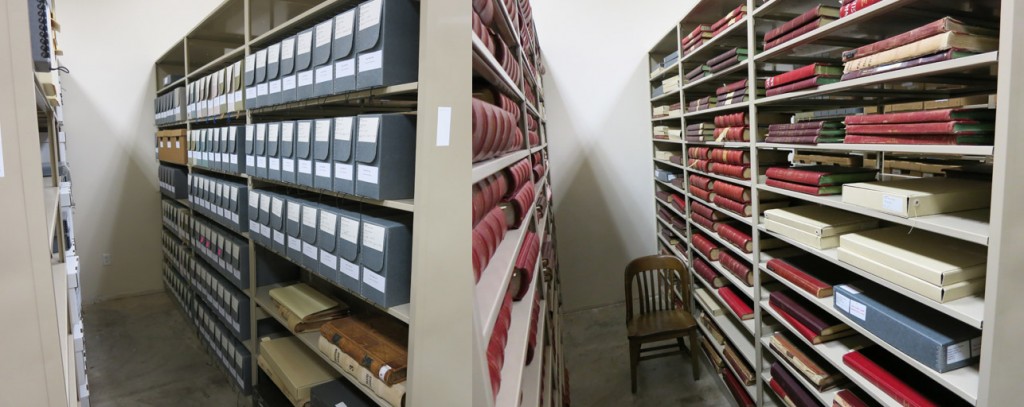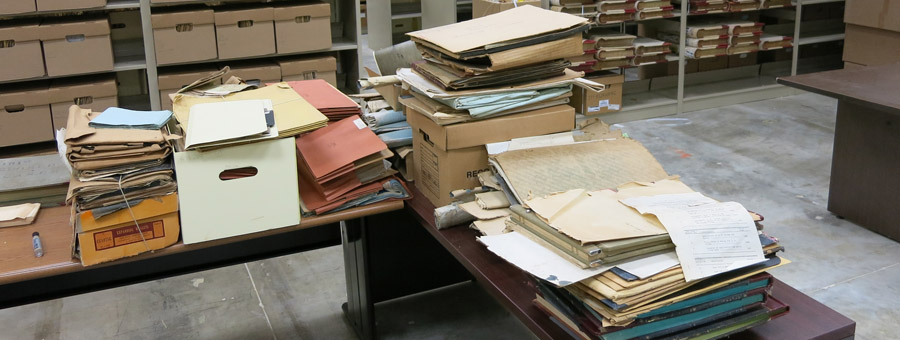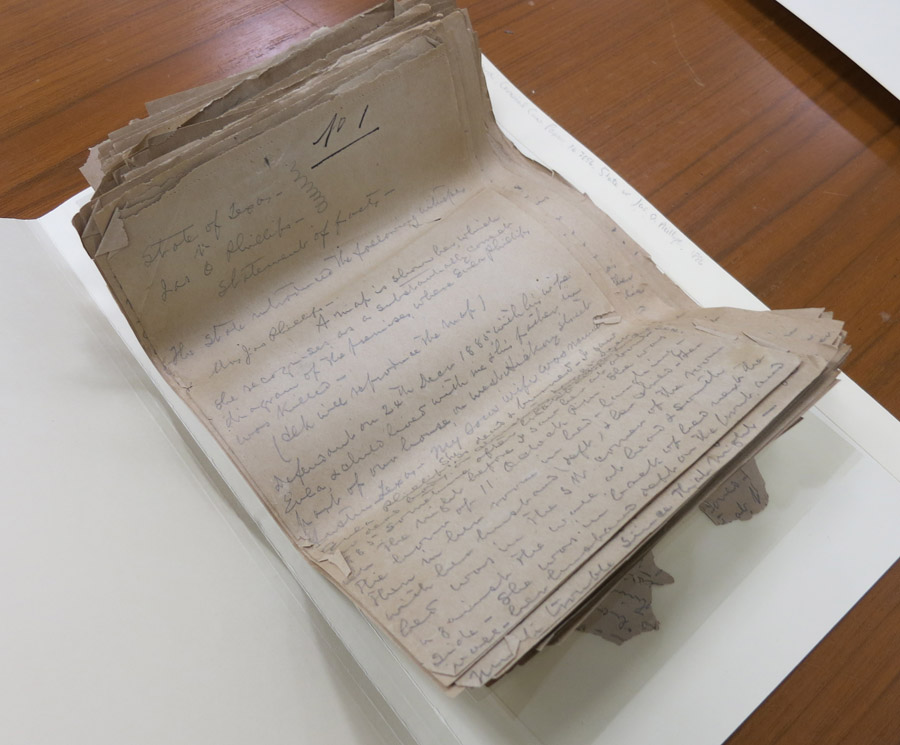The mission of the Travis County Archives is to serve the government and the community of Travis County by documenting, preserving, and making available its records and history.
The Travis County Archives documents the functions and activities of the Travis County government, supports the conduct of the government by preserving and providing access to essential county records, and maintains the history of the county and its community through the preservation of records with historical value.
Earlier this summer I had a chance to talk with Travis County Archivist Christy Moilanen about an exciting discover she recently made – the original handwritten trial transcripts and inquest reports of the Susan Hancock and Eula Phillips murder cases. I was invited to take a look at the original documents, take some photographs and talk with Christy about how she found them, and get a tour of their facilities and see some of the materials they have in their collection.
J. R. Galloway: Many years ago, back in the 90s, when I first became interested in the murders, I had asked at the Travis County Courthouse and the Austin History Center whether any original trial transcripts or inquest records from the 1885 murders still existed and was told that they did not, so I was surprised to hear you had found them. How did you come across them?
Christy Moilanen: I was fortunate to have a few University of Texas iSchool students volunteering in the archives over the spring and early summer, reboxing a large amount of material that had been stored in a warehouse since the 1980s. The particular box in which these documents were found was unmarked; my attention was initially drawn to it because of the District Court civil case papers it contained, many of which dated all the way back to the 1840s. At the bottom of the box were several larger documents folded up. I carefully unfolded them and was surprised to realize they related to the so-called Servant Girl murders. The records included a transcript of the case against James Phillips, a transcript of the case against Moses Hancock, and an inquest and autopsy relating to the death of Susan Hancock.
J. R. Galloway: How would you describe their condition when you found them?
Christy Moilanen: The documents were in fairly decent condition, all things considered, but I wouldn’t say they were in good condition. They had been stored in the bottom of a box that had been in a non-climate controlled space for at least several decades. The documents were folded up, so they needed to be carefully flattened in order to be read, and many of the pages, all of which are loose, had damaged edges and pieces flaking off.
The transcripts of the cases against James Phillips and Moses Hancock are in the worst condition. The Phillips transcript is written in pencil on plain brown paper, much of which has damage along the edges, and at least one page is completely in pieces. The Hancock case is written in iron gall ink, which has contributed to the brittleness and fragility of the paper. Fortunately, however, the transcripts are mostly legible, even though the script takes some deciphering.
The Susan Hancock inquest and autopsy are in rather good condition, perhaps partially due to the smaller size of these records. While the transcripts are around 100 pages each, the inquest is 34 pages and the autopsy is just 4 pages. The inquest was written in ink on pages that appear to be torn from a pad or notebook, and the autopsy is penned on paper from the Texas State Medical Association.
J. R. Galloway: I was surprised by the comparatively good condition of the documents considering how old they are and that they just loose pages, and you mentioned a couple of pages were lost?
Christy Moilanen: The transcript for the case against Moses Hancock is missing the first four pages. It’s hard to say how and when they were separated from the rest of the document.
J. R. Galloway: It’s interesting that the brown paper has perforations and it sort of resembles wrapping paper from a dispenser.
Christy Moilanen: Based on other records the Archives has of the Justices of the Peace from that time period, it seems that they often wrote their documents on whatever paper was at hand, so the inquest seems pretty typical. It is more surprising to me that the court transcripts were written on such nondescript paper, and one in pencil, no less.
J. R. Galloway: What steps are you taking to preserve them? What are your procedures in dealing with these kinds of materials?
Christy Moilanen: All of the documents have been carefully unfolded and flattened, and they have been placed into acid-free folders. Pages that are in more advanced states of deterioration or at risk of falling apart have been placed into mylar sleeves, to prevent any direct handling that could cause further damage. Because our conservation resources are limited, our preservation efforts focus on stabilization and prevention of further damage.
J. R. Galloway: Have you had a chance to read the transcripts yourself? Did you come across anything interesting?
Christy Moilanen: I have read through the inquest and the autopsy. It was very interesting to read the accounts recorded by the Justice of the Peace in the inquest record, of the neighbors and of Moses Hancock himself. Their descriptions of the event are rather detailed, and it makes one want to look for clues as to the identity of the killer. One of the more curious accounts was given by neighbor Hester Campbell, who claimed to have had dreams about the murders prior to their occurrence.
J. R. Galloway: Have you come across any other documents relating to any of the other 1885 murder cases?
Christy Moilanen: Unfortunately I haven’t. Papers from the cases against James Phillips and Moses Hancock are on microfilm at the District Clerk’s office, but these four documents — the inquest, the autopsy, and the two transcripts — are the only original records I’ve seen. Interestingly, the Phillips and Hancock transcripts are not part of the microfilmed record, so this is the first time they have been viewed in quite a long time.
J. R. Galloway: The archives are currently housed at the Travis County Sheriff’s office, how did that collaboration come about? There seems to be a lot of interest in local history at the Sheriff’s Department, I noticed several historical photographs and maps in the lobby.
Christy Moilanen: We’ve been in our current space in the Sheriff’s Office building since 2010. The archives program is relatively new, and when we started looking for space, there weren’t many options available to us. Fortunately, there was a large empty space, approximately 5,000 square feet, at the back of the Sheriff’s building. Both the Sheriff’s Office and the County Commissioners were agreeable to us moving into that space, and we have gradually been filling it out since then. We are fortunate to have a great relationship with the Sheriff’s Office, and in particular, Chief Deputy Jim Sylvester, who has a great interest in history.
J. R. Galloway: You maintain the Travis County Archives webpage and blog which details the Travis County Archives’ history, mission, current work and projects — what’s coming up for the archives?
Christy Moilanen: I try to keep the website and blog up-to-date with current happenings. One of our biggest projects is the upcoming annual event called Travis County History Day. In the six since its inception, History Day has proven to be a wonderful opportunity to celebrate and to educate others about the rich history of Travis County. This year, we are celebrating the 100th anniversary of the Smith-Lever Act, which provided funding for extension services throughout the country. Extension services have touched and improved the lives of countless Travis County residents throughout the years, and we want to commemorate the tireless work extension agents and staff have done for our community. History Day will be held on October 24, from 10am to noon, in the Hall of Government at 700 Lavaca Street in downtown Austin. The event will feature special speakers, historical exhibits, and refreshments, and we welcome the public to join us!
The Travis County Archives will also be a participant in the 1st annual Austin Archives Bazaar, a fun and interactive gathering of 22 local archives. This is a great opportunity to come out and learn about what our many Austin-area archives have to offer. The Bazaar will be held on October 19, 2014, from 2 to 6pm, at the Spider House Ballroom.









